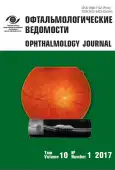Сравнительная оценка цитотоксичности антимикробных глазных капель фторхинолонового ряда и её влияние на биодоступность препаратов
- Авторы: Хинтуба Т.С.1, Тахтаев Ю.В.2, Околов И.Н.3, Мотылева В.А.1, Шлякман Р.Б.2
-
Учреждения:
- ФГБОУ ВО «Северо-Западный государственный медицинский университет им. И.И. Мечникова» Минздрава России
- ФГБОУ ВО «Первый Санкт-Петербургский государственный медицинский университет имени академика И.П. Павлова» Минздрава России
- Санкт-Петербургский филиал ФГАУ МНТК «Микрохирургия глаза» им. акад. С.Н. Фёдорова
- Выпуск: Том 10, № 1 (2017)
- Страницы: 77-86
- Раздел: Статьи
- URL: https://journals.rcsi.science/ov/article/view/6319
- DOI: https://doi.org/10.17816/OV10177-86
- ID: 6319
Цитировать
Аннотация
Помимо широты спектра активности антибактериальных препаратов (АБП), а также их фармакодинамических и фармакокинетических особенностей, важным аспектом является безопасность лекарственного средства и его биодоступность. В настоящее время нет единого мнения о токсичности фторхинолонов.
Цель данного исследования состояла в сравнении общего цитотоксического действия на эпителий роговой оболочки и биодоступности трёх антибактериальных глазных капель фторхинолонового ряда, зарегистрированных в Российской Федерации: 1) Офтаквикс™ (левофлоксацин 5 мг/мл; консервант бензалкония хлорид (БАХ) 0,05 мг/мл; производитель: АО «Сантэн», Финляндия), далее — «левофлоксацин (оригинальный)»; 2) Сигницеф® (левофлоксацин 5 мг/мл; консервант БАХ 0,1 мг/мл; производитель: «Сентисс Фарма Пвт. Лтд.», Индия), далее — «левофлоксацин (дженерик)»; 3) Вигамокс® (моксифлоксацин 5 мг/мл; без консервантов; производитель: «Алкон Лабораториз, Инк.», США), далее — «моксифлоксацин» с использованием методов in vivo и определением возможного влиянии наличия консерванта (в различной концентрации) или его отсутствия на достижение минимальных пороговых концентраций (МПК) антибиотика во влаге передней камеры глаза (ВПКГ), с использованием методов высокоэффективной жидкостной хроматографии (ВЭЖХ) в сочетании с масс-спектрометрическим детектированием (МС). Исследование показало, что протестированные АБП могут оказывать цитостатический эффект в условиях in vivo на эпителий роговицы и отличаются по своему цитотоксическому потенциалу. Присутствие бензалкония хлорида в препарате Сигницеф в концентрации, превышающей в два раза концентрацию консерванта основного препарата (Офтаквикс), оказывает воздействие на эпителиальный слой роговицы, что подтверждается данными конфокальной микроскопии, и способно повлиять на биологическую доступность лекарственного средства.
Ключевые слова
Полный текст
Открыть статью на сайте журналаОб авторах
Тамара Славиковна Хинтуба
ФГБОУ ВО «Северо-Западный государственный медицинский университет им. И.И. Мечникова» Минздрава России
Автор, ответственный за переписку.
Email: khintubatamara@gmail.com
аспирант кафедры офтальмологии
Россия, Санкт-ПетербургЮрий Викторович Тахтаев
ФГБОУ ВО «Первый Санкт-Петербургский государственный медицинский университет имени академика И.П. Павлова» Минздрава России
Email: ytakhtaev@gmail.com
д-р мед. наук, профессор кафедры офтальмологии
Россия, Санкт-ПетербургИгорь Николаевич Околов
Санкт-Петербургский филиал ФГАУ МНТК «Микрохирургия глаза» им. акад. С.Н. Фёдорова
Email: ytakhtaev@gmail.com
канд. мед. наук, заведующий клинико-бактериологической лабораторие
Россия, Санкт-ПетербургВера Александровна Мотылева
ФГБОУ ВО «Северо-Западный государственный медицинский университет им. И.И. Мечникова» Минздрава России
Email: ytakhtaev@gmail.com
врач-офтальмолог, аспирант кафедры офтальмологии
Россия, Санкт-ПетербургРоман Борисович Шлякман
ФГБОУ ВО «Первый Санкт-Петербургский государственный медицинский университет имени академика И.П. Павлова» Минздрава России
Email: ytakhtaev@gmail.com
врач-офтальмолог, аспирант кафедры офтальмологии
Россия, Санкт-ПетербургСписок литературы
- Астахов С.Ю., Вохмяков А.В. Офтальмологические фторхинолоны в лечении и профилактике глазных инфекций // Клиническая офтальмология. – 2008. – Т. 9. – № 1. – С. 28–30. [Astakhov SYu, Vokhmyakov AV. Oftal´mologicheskie ftorkhinolony v lechenii i profilaktike glaznykh infektsiy. Klinicheskaya oftal´mologiya. 2008;9(1):28-30. (In Russ.)]
- Астахов С.Ю., Вохмяков А.В. Эндофтальмит: профилактика, диагностика, лечение // Офтальмологические ведомости. – 2008. – Т. 1. – № 1. – С. 35–45. [Astakhov SYu, Vokhmyakov AV. Endoftal´mit: profilaktika, diagnostika, lechenie. Oftal´mologicheskie vedomosti. 2008;1(1):35-45. (In Russ.)]
- Вохмяков А.В., Околов И.Н., Гурченок П.А. Выбор оптимального антибиотика для профилактики инфекционных осложнений в офтальмохирургии // Клиническая офтальмология. – 2007. – Т. 8. – № 1. – С. 37–40. [Vokhmyakov AV, Okolov IN, Gurchenok PA. Vybor optimal›nogo antibiotika dlya profilaktiki infektsionnykh oslozhneniy v oftal´mokhirurgii. Klinicheskaya oftal´mologiya. 2007;8(1):37-40. (In Russ.)]
- Морозова Т.Е., Криворотова Н.В., Каракашев Г.В., и др. Качественное и количественное определение антибиотиков фторхинолонового ряда в содержимом передней камеры глаза методом ВЭЖХ — МС. Всероссийский симпозиум «Кинетика и динамика обменных процессов». Краснодарский край. 2012. – C. 51–52. [Morozova TE, Krivorotova NV, Karakashev GV, et al. Kachestvennoe i kolichestvennoe opredelenie antibiotikov ftorkhinolonovogo ryada v soderzhimom peredney kamery glaza metodom VEZhKh-MS. (Conference proceedings) Vserossiyskiy simpozium “Kinetika i dinamika obmennykh protsessov”. Krasnodarskiy kray. 2012. P. 51-52. (In Russ.)]
- Околов И.Н., Гурченок П.А., Вохмяков А.В. Нормальная микрофлора конъюнктивы у офтальмохирургических пациентов // Офтальмологические ведомости. – 2008. – Т. 1. – № 3. – С. 18–21. [Okolov IN, Gurchenok PA, Vokhmyakov AV. Normal´naya mikroflora kon´yunktivy u oftal´mokhirurgicheskikh patsientov. Oftal´mologicheskie vedomosti. 2008;1(3):18-21. (In Russ.)]
- Околов И.Н., Поляк М.С. Моксифлоксацин как средство профилактики и лечения инфекции глаз // Новое в офтальмологии. – 2011. – № 3. – С. 64–71. [Okolov IN, Polyak MS. Moksifloksatsin kak sredstvo profilaktiki i lecheniya infektsii glaz. Novoe v oftal´mologii. 2011;(3):64-71. (In Russ.)]
- Arantes T, Cavalcanti R, Diniz M, et al. Conjunctival bacterial flora and antibiotic resistance pattern in patient undergoing cataract surgery. Arq Bras Ophthalmol. 2006;69(1):33-36. doi: 10.1590/S0004-27492006000100007.
- Chang D, Braga-Mele R, Mamalis N, et al. Prophylaxis of postoperative endophthalmitis after cataract surgery ASCRS Cataract Clinical Committee. J Cataract Refract Surg. 2007;33(10):1801-1805. doi: 10.1016/j.jcrs.2007.07.009.
- ESCRS Guidelines on prevention, investigation and management of postoperative endophthalmitis. Version 2 / Editors: P. Barry, W. Behrens-Baumann, U. Pleyer, D. Seal. ESCRS. 2007. 37 p.
- Hehl E, Beck R, Luthard K, et al. Improved penetration of aminoglycosides and fluoroquinolones into the aqueous humour of patients by means of Acuvue contact lenses. Eur J Clin Pharmacol. 1999;55(4):317-323. doi: 10.1007/s002280050635.
- Koch R, Kulus S, Roessler M, et al. Corneal penetration of fluoroquinolones: aqueous humor concentrations after topical application of levofloxacin 0.5% and ofloxacin 0.3% eyedrops. J Cataract Refract Surg. 2005;31(7):1377-1385. doi: 10.1016/j.jcrs.2004.12.063.
- Kovoor T, Kim A, McCulley J. Evaluation of corneal effects of topical ophthalmic fluoroquinolones using in vivo confocal microscopy. Eye Contact Lens. 2004;20:90-94. doi: 10.1097/01.ICL.00000117255.97190.98
- Mino de Kaspar H, Kreutzer TC, Aguirre-Romo I. A prospective randomized study to determine the efficacy of preoperative topical levofloxacin in reducing conjunctival bacterial flora. Am J Ophthalmol. 2008;145(1):136-142. doi: 10.1016/j.ajo.2007.08.031.
- Sandvig KU, Dannevig L. Postoperative endophthalmitis: Establishment and results of a national registry. J Cataract Refract Surg. 2003;29(7):1273-1280. doi: 10.1016/S0886-3350(02)02048-5.
- Tan C, Wong H, Yang F. Epidemiology of postoperative endophthalmitis in an Asian population: 11-year incidence and effect of intracameral antibiotic agents. J Cataract Refract Surg. 2012;38(3):425-30. doi: 10.1016/j.jcrs.2011.09.040.
Дополнительные файлы







